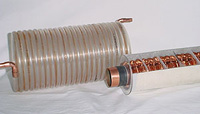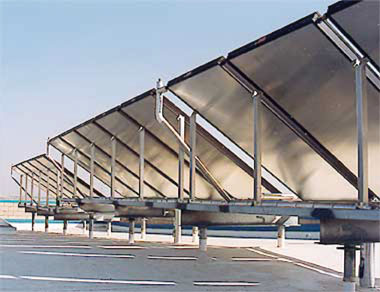How Green Is Copper?
 Copper drainwater heat recovery system for sinks and washing machines.
Copper drainwater heat recovery system for sinks and washing machines. Photo courtesy of Winston Works Inc.
High-resolution version of this photo.
Imagine walking into an unfamiliar store and, within seconds, you are handed a personalized list of items to match your size, color preferences and current wardrobe. At home, your refrigerator and pantry let you know which foods have spoiled, and what items need to be replenished. At work, a pocket computer tells you the life history, location and operating status of every item in your company's inventory.
This was once the stuff of science fiction. Today it's fact - or soon to be reality - thanks to a little tag attached to your clothing, imprinted on your food packaging, or embedded in virtually all products inventoried and sold by businesses worldwide. It's all possible because of radio frequency identification or RFID, a technology that has been around for more than 20 years but is now about to revolutionize our lives. Copper plays a critical role in itsdevelopment.
RFID is an electronic identification system that recognizes objects tagged with a unique code or serial number. This code is similar to a bar code label, but an RFID tag contains a microchip that can store up to 2 kilobytes of data. Its copper circuitry and attached radio antenna transmit the information to a reader or monitoring system. Because RFID uses radio waves to send this data, line-of-sight visibility from tag to reader is unnecessary.
One day soon, many - if not most - of the items we use in our lives will be embedded with RFID tags. Chances are you may already have one or more RFID devices in your possession. They are the brains behind smart card technology used in credit card and mass transportation systems worldwide. They enable the identification cards that grant access to buildings and office doors. Encapsulated in a sliver of glass and implanted under the skin, they allow veterinarians, farmers and animal control personnel to identify missing and wayward animals.
The potential of RFID is enormous. Not only will the tags provide inventory, security and logistical information, they will also provide retailers with an individualized marketing tool. In the future, we are likely to see this technology used in ways we have not anticipated. As pharmaceutical companies have recently discovered, they are an ideal way to prevent international counterfeiting in medicines. The same methods eventually will help secure and identify other illegally trafficked products, from DVD's to automobiles to exotic pets.
Help From a Giant
Being "green" isn't always the most economical option for residential and commercial buildings, but it can help reduce your overall operating expenses and costs over the long term. Now, however - thanks to Uncle Sam - it can begin saving you money right away.
The Energy Policy Act of 2005 provides homeowners with a variety of tax credits that reduce the amount of taxes paid to implement green or energy saving practices. Homeowners can qualify for up to $500 in tax credits for home improvements to windows, doors, HVAC systems, roofing, insulation, heat pumps and water heaters. Tax credits up to $2,000 are also available for qualifying solar water heating and photovoltaic systems.
One green system that qualifies for energy tax credits is a direct exchange, or DX, geothermal heat pump that uses copper tubing to harvest the earth's thermal energy for heating and cooling. The system consists of an underground heat exchanger connected to a network of copper pipes filled with a refrigerant. Heat in the ground is transferred by the refrigerant and released throughout the system by an in-home air handler and heating coil. The exceptional heat transfer properties of the copper tubing make it an integral part of the direct exchange thermal system, which translates into a 30- to 60-percent reduction in heating and cooling costs for homeowners.
Another home heating system that qualifies for tax credits uses copper-intensive passive solar collectors. Designed to heat water, this technology has been in widespread use for more than three decades. A new solar technology that uses copper-based photovoltaic (PV) cells is poised for commercialization in the near future. Unlike the passive units, PV systems convert sunlight directly into electricity. The cells are a complex alloy of copper and rare elements such as indium and selenium. Highly efficient and much less expensive to manufacture than traditional silicon-based cells, they are completely silent, require no fuel and minimal maintenance and, most importantly, are powered by the world's largest and least-expensive renewable energy source, the sun.
Copper roofs are valued for their aesthetic beauty, durability, low maintenance and high recycled content. Copper tubing is the preferred choice for plumbing systems, and copper is also the best material for electrical performance. Copper wiring, motors, magnet windings and transformers help make energy production, transmission and use more efficient.
Green Building and Copper
The construction industry is going green for good reason. Residential and commercial buildings are responsible for 40 percent of the world's energy use and 16 percent of the world's water consumption. In this country, the residential and commercial building industry is the largest manufacturing sector, encompassing more than 13 percent of our gross domestic product.
As energy and raw material costs continue to skyrocket, building owners, architects, developers and contractors are searching for ways to incorporate green or "sustainable" building practices into their programs. Their goal is to reduce energy consumption and the environmental impact of their buildings while providing long-term economic returns on this important investment.
 Copper-intensive passive solar collectors.
Copper-intensive passive solar collectors.Green building promotes structures that are healthier for occupants as well as for the environment in general. This goes well beyond energy and water conservation. Through such practices as environmentally sensitive site planning, attention to indoor environmental quality, and the use of resource-efficient building materials like copper, these initiatives can also help to lower utility operating costs, enhance community health and increase overall workforce productivity, all while minimizing the negative effects that construction and energy consumption may have on the environment and global climate change.
At the forefront of the green building movement is the United States Green Building Council (USGBC), which has created the "Leadership in Energy and Environmental Design," or LEED, point-rating system. This voluntary standard was developed to help propel the mainstream home and commercial building industry toward sustainable practices while creating a common format for their measurement. For example, a typical home needs to obtain 30 of a possible 108 LEED points to achieve certified status, and 90 out of 108 to achieve LEED platinum - the highest performance level.
Copper can be found making an impact throughout any building. According to Tom Dietsche, LEED Program Manager, USGBC, "Green Building projects that can earn LEED points include those that have incorporated recycled content materials, such as copper, which promotes sustainability and helps to reduce the impact of new material extraction on the environment." Copper is a vital part of hot water recovery systems that help recapture used thermal energy.
Green building standards concern every aspect of the home, but are primarily focused on insulation, the indoor air quality system (heating, ventilation and air conditioning, or HVAC), exterior landscaping, and construction materials. Additional LEED points may be awarded for environmentally friendly objectives like non-toxic pest control, radon protection and innovation in the design process.
Recently, the National Association of Home Builders (NAHB) began promoting its own green building standards. These guidelines complement the LEED system and provide an additional avenue for certification.
Copper Leads the Way
It is estimated that about 80 percent of all the copper ever mined (about 13 percent of the world's reserves) is still in use in one form or another today, making copper one of the planet's most sustainable materials. It has the highest recycling rate of any engineered metal. Some products, such as copper tube and sheet goods, can be recycled over and over without any loss to their engineering properties. In its pure form, and in alloys like brass and bronze, it is practically 100 percent recyclable. Excluding wire production, copper- based products contain about 75 percent recycled copper.
Recycled copper helps to conserve the earth's resources - one of the ultimate goals of the green building movement. Copper will continue to play a crucial role in sustainable development now and in the future. Cu
Resources:
Also in this Issue:
- Tag, You're It - Tomorrow's ID Is An RFID
- How Green Is Copper?
- Color Trends of the Year: Copper, Brass, Bronze
- HDTV + Copper = Maximum Effect
- Copper Can Help Contain Flu
